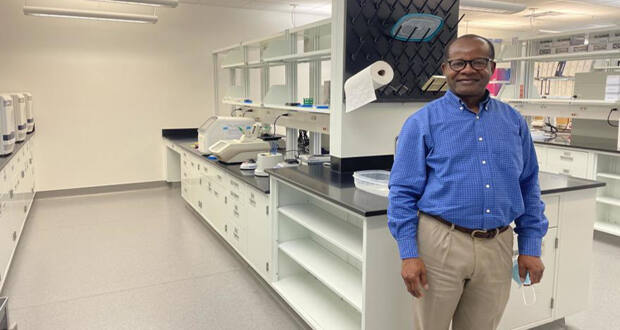A Kansas animal disease lab could help prevent the next pandemic

At the height of the COVID-19 pandemic, animal disease labs across the country stepped up to expand testing capacity, and they could play a role in preventing the next pandemic.
Spillover events – animal diseases that jump to humans – happen often, according to Jonna Mazet, a professor of epidemiology and disease ecology at the University of California – Davis School of Veterinary Medicine.
Most novel diseases and emerging infections that jump from one species to another don’t cause big problems, she says. In other cases, it can be bad.
“Sometimes things jump into livestock, cook along and then jump into people or affect our food supply so devastatingly that it has a major effect on food security,” Mazet says.
As a global director for a project called PREDICT, which detected emerging diseases around the world that could transfer from animals to humans, she says her team detected hundreds of novel coronaviruses and other viruses.
Diseases can be devastating for the agricultural sector too. One example is African swine fever, which is affecting producers in China.
“You planned your business to have so many born, so many get raised up and go to market,” says
Corinne Bromfield is a swine extension veterinarian at the University of Missouri. “And if they get born, but they don’t go to market, or even if they don’t get born, because there’s sows aborting, all of that is really detrimental to the industry.”
Animal disease labs during COVID-19
Animal disease experts and the USDA were already involved in the COVID-19 pandemic. Labs like the Oklahoma Animal Disease Diagnostic Laboratory in Stillwater stepped up to expand testing capacity. Jerry Saliki, the lab’s director, said they had to reassign and hire more staff and rapidly train them. People were working 12 to 18 hours every day.
“It was like a wartime effort,” Saliki says.
The lab is part of the National Animal Health Laboratory Network, a network of state labs that work with the USDA to surveil animal diseases. Saliki says animal testing diagnostic labs are used to tracking large-scale outbreaks, which is why they have more equipment capacity than public health labs.

The Oklahoma Animal Disease Diagnostic Laboratory used these machines to process COVID-19 tests. Since animal disease experts are used to tracking large numbers of infected animals, labs have larger capacities to run tests.
“Rarely does a period of five years go by without a major outbreak of a disease involving millions of one animal species. So we have that experience over a long period of time,” Saliki says.
Preventing future pandemics
In the past 10 years, more than 70% of the emerging diseases that have affected humans have an animal component. That’s according to Ken Burton, a coordinator for the National Bio and Agro-Defense Facility (NBAF).

The U.S. Department of Agriculture is working with the Department of Homeland Security to create the massive lab in Manhattan, Kansas, with the goal of preventing any emerging diseases that might threaten the food supply chain or agriculture industry. NBAF will also work on vaccine development and hold a vaccine bank for foot-and-mouth disease, Burton says. When the next pandemic rolls around, their facility could play a part in preventing it, he says.
READ: Lifeguard shortage may affect Kansas pool openings this summer
“It could provide a supporting role in future public health crises with relation to the basic animal research that’s done, and diagnostics and countermeasure development in addition to training and response,” Burton says.
Experts like Mazet think government facilities like NBAF play a role in preventing diseases, but there needs to be early monitoring and action to prevent diseases.
“We should have been ready and been watching for all these coronaviruses that we know can jump species earlier,” Mazet says. “But even when it happens, then we waited … before the international community jumped in. So we need to have that early flag, respond quickly and largely, and then scale back when we get it under control or if it’s not a real problem.”
Mazet says this will require a change in mindset.
“What I’ve seen throughout my career, we had … to stop working on Ebola and funding got shifted to Zika. So that’s the way humans behave,” Mazet says. “And we need to figure out how we can adjust our own behavior to be better prepared.”
NBAF is expected to open in October and be fully operational by 2023. Burton says disease labs now have a better roadmap for how to help during the next pandemic.
“Collaborations not only within the agricultural community, but also the crossover between the human side and the animal side is going to be extremely important going forward,” Burton says.
–KCUR | Seth Bodine | Harvest Public Media







